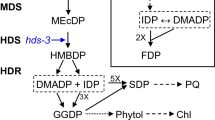Abstract.
Isoprene (2-methyl-1,3-butadiene) is the most abundant biogenic hydrocarbon released from vegetation, and there is continuing interest in understanding its biosynthesis from photosynthetic precursors in leaf chloroplasts. We used on-line proton-transfer-reaction mass spectrometry (PTR–MS) to observe the kinetics of 13C-labeling of isoprene following exposure to 13CO2 and then the loss of 13C after a return to normal 12CO2 in oak (Quercus agrifolia Nee) and cottonwood (Populus deltoides Barr.) leaves. Assignments of labeled isoprene species were verified by gas chromatography–mass spectrometry. For the first time, it was possible to observe the half-lives of individually 13C-labeled isoprene species during these transitions, and to trace some of the label to a C3 fragment that contained the two isoprene carbons derived from pyruvate via the deoxyxylulose-5-phosphate (DOXP) pathway. At steady state (under 13CO2), approximately 80% of isoprene carbon was labeled, with fully labeled isoprene as the major species (approx. 60%). The source of the unlabeled C is suggested to be extrachloroplastic, but not from photorespiratory carbon. After a transfer to 12CO2, 13C-labeling persisted in one isoprene carbon for several hours; this persistence was much more pronounced in (i) leaves inhibited by fosmidomycin, a specific inhibitor of the DOXP pathway, and (ii) in sun leaves which have higher ratios of soluble sugars to starch. From the mass 41–44 fragment data, and labeling predicted from the DOXP pathway in chloroplasts, precursors may arise from cytosolic pyruvate/phosphoenolpyruvate equivalents transported into the chloroplast; this idea was supported by an indirect measure of pyruvate labeling. Other sources of cytosolic isoprene precursors (i.e. dimethylallyl diphosphate or pentose phosphate) could not be excluded. The data obtained shed light on the half-lives of photosynthetic metabolites, exchanges of carbon between cellular pools, and suggest multiple origins of isoprene precursors in leaves.
Similar content being viewed by others
Author information
Authors and Affiliations
Additional information
Electronic Publication
Rights and permissions
About this article
Cite this article
Karl, .T., Fall, .R., Rosenstiel, .T. et al. On-line analysis of the 13CO2 labeling of leaf isoprene suggests multiple subcellular origins of isoprene precursors. Planta 215, 894–905 (2002). https://doi.org/10.1007/s00425-002-0825-2
Received:
Accepted:
Issue Date:
DOI: https://doi.org/10.1007/s00425-002-0825-2




